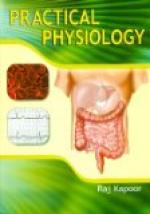[Illustration: Fig. 60.—Diagrammatic Scheme of Intestinal Absorption.
A, mesentery;
B, lacteals and mesentery glands;
C, veins of intestines;
R.C, receptacle of the chyle (receptaculum
chyli);
P V, portal vein;
H V, hepatic veins;
S.V.C, superior vena cava;
R.A, right auricle of the heart;
I.V.C, inferior vena cava.
]
The inner surface of the small intestine also secretes a liquid called intestinal juice, the precise functions of which are not known. The chyme, thus acted upon by the different digestive fluids, resembles a thick cream, and is now called chyle. The chyle is propelled along the intestine by the worm-like contractions of its muscular walls. A function of the bile, not yet mentioned, is to stimulate these movements, and at the same time by its antiseptic properties to prevent putrefaction of the contents of the intestine.
153. Digestion in the Large Intestines. Digestion does not occur to any great extent in the large intestines. The food enters this portion of the digestive canal through the ileo-caecal valve, and travels through it slowly. Time is thus given for the fluid materials to be taken up by the blood-vessels of the mucous membrane. The remains of the food now become less fluid, and consist of undigested matter which has escaped the action of the several digestive juices, or withstood their influence. Driven onward by the contractions of the muscular walls, the refuse materials at last reach the rectum, from which they are voluntarily expelled from the body.
Absorption.
154. Absorption. While food remains within the alimentary canal it is as much outside of the body, so far as nutrition is concerned, as if it had never been taken inside. To be of any service the food must enter the blood; it must be absorbed. The efficient agents in absorption are the blood-vessels, the lacteals, and the lymphatics. The process through which the nutritious material is fitted to enter the blood, is called absorption. It is a process not confined, as we shall see, simply to the alimentary canal, but one that is going on in every tissue.
The vessels by which the process of absorption is carried on are called absorbents. The story, briefly told, is this: certain food materials that have been prepared to enter the blood, filter through the mucous membrane of the intestinal canal, and also the thin walls of minute blood-vessels and lymphatics, and are carried by these to larger vessels, and at last reach the heart, thence to be distributed to the tissues.




